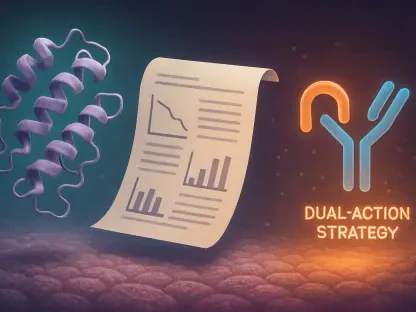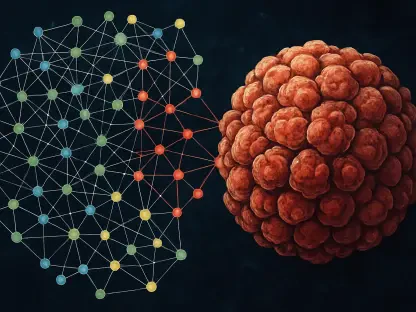Schrödinger, a well-established player in the computational chemistry and drug discovery space, has recently made headlines by embracing artificial intelligence (AI). The company’s CEO, Ramy Farid, officially announced this strategic pivot during the presentation of the company’s year-end results for 2024, signaling a new era for Schrödinger and its stakeholders. This shift marks a significant transformation in the firm’s approach, promising enhancements in drug discovery processes and potential growth in the biopharma sector.
The Catalyst for Change
The catalyst for Schrödinger’s pivot towards AI was a dinner meeting between CEO Ramy Farid and NVIDIA CEO Jensen Huang. Huang encouraged Farid to integrate AI more prominently into Schrödinger’s business model and to invest heavily in GPU technology to enhance their computational capabilities. This conversation allegedly influenced Schrödinger’s newfound emphasis on AI, formally acknowledged during the presentation of the company’s 2024 year-end results.
Following this interaction, Schrödinger decided to integrate AI more prominently, aiming to address market pressures and its positioning among competitors. This move was not just sporadic but a well-thought-out strategy to stay relevant and competitive in the rapidly evolving biotech landscape. Schrödinger’s cautious approach shifted dramatically, compelled by market pressures and competition, positioning AI as a cornerstone of its future endeavors in drug discovery.
Evolving Business Model
Schrödinger has long been known for its dual identity—as both a computational software provider and a biotech firm. This unique positioning allows the company to serve a majority of the top 20 pharmaceutical companies globally, while also venturing into its own drug discovery initiatives. Schrödinger’s software supports a majority of the top 20 pharmaceutical companies globally and also engages directly in drug development endeavors. The company’s goal is to leverage its software to develop proprietary therapeutics, potentially revolutionizing treatments for conditions like cancer. However, this dual focus presents evaluation challenges and complicates the company’s valuation.
The core objective is to harness its computational prowess to uncover new therapeutics, potentially providing groundbreaking treatments for various conditions, including complex cancers. Nonetheless, this duality introduces uncertainties in valuation, reflecting the inherent challenges of balancing software provision with high-stakes drug development efforts. This blending of software and biotech domains represents a strategic approach but also highlights the complexities and risks associated with managing such diverse operational focuses.
Software Revenue and SaaS Transformation
In 2024, Schrödinger’s software portfolio contributed 86.5% of its revenues, amounting to $180 million—an increase from $159 million in 2023. Schrödinger’s software segment has witnessed steady growth, attributable to the transition from on-premise licenses to cloud-based software-as-a-service (SaaS) solutions. Notably, this expansion is driven by the demand from the company’s largest clients, reflecting broader market trends towards cloud solutions.
Cloud-based contracts constituted 20% of the software revenue in 2024, up from 13% in 2023. Highlighting this growth trajectory, Schrödinger’s shift from on-premise licenses to SaaS aligns with the broader market transition. The largest clients represented 13% of the customer base but contributed to a significant 87% of the annual contract value (ACV). This shift impacts revenue positively despite customer acquisition costs, emphasizing the value of flexible, scalable cloud solutions in driving industry standards forward.
Customer Base and Revenue Distribution
A noteworthy point from Schrödinger’s revenue distribution is the high concentration of revenue among its top-tier customers, with over 1,750 software clients but a significant revenue proportion emanating from just 235 clients. This composition indicates a stable, high-value client base offsetting churn among smaller biotech firms, which face industry consolidations or shutdowns. Schrödinger’s sizable client base reveals a pronounced revenue concentration among larger clients, underscoring the importance of these high-value relationships in maintaining financial stability.
Despite its robust clientele, Schrödinger faces a deceleration in software revenue growth, forecasted to slow down to 12% in the coming year. This slowdown raises questions about the software segment’s total addressable market (TAM). To counter these challenges, Schrödinger must focus on attracting high-expenditure clients, ensuring sustainable growth amidst evolving industry dynamics.
Dual Focus on Drug Discovery
Beyond software, Schrödinger’s revenue model includes milestone payments and royalties from drug discovery collaborations, although these earnings have high variability and unpredictability. The firm reported a 50% drop in drug discovery revenues in 2024, reflecting a challenging segment fraught with uncertainties. Schrödinger’s dual focus on software and drug discovery encompasses high-risk, high-reward projects that involve significant collaborations with pharmaceutical giants.
A prime example is their lucrative deal with Novartis, valued at up to $2.3 billion, which provided an immediate $150 million upfront payment. However, the bulk of those revenues depend on milestone achievements and projections over the coming years, underlining the inherent unpredictability. This model underscores the potential for substantial rewards, though the volatility necessitates careful strategic planning.
Internal Drug Discovery Investments
A substantial portion of Schrödinger’s financial resources is dedicated to internal drug discovery programs. Approximately 50% of its $200 million R&D expenditure in the current year targeted its drug pipeline. This significant investment highlights the company’s ambition yet underscores the concerning financial load, casting doubt on the pragmatical long-term outcome of these R&D efforts.
Three leading drug candidates from Schrödinger are expected to deliver phase 1 results in 2025, marking pivotal milestones that could either validate or jeopardize the company’s platform and external reputation. Success in these trials would escalate subsequent phase trials’ costs, amplifying both risks and rewards. The outcomes of these trials will be critical in determining the feasibility and impact of Schrödinger’s drug discovery platform.
Embracing AI and Competitive Positioning
Acknowledging AI’s potential, Schrödinger has initiated the integration of AI/ML into its drug discovery workflows. A new initiative focuses on early toxicology risk prediction using a $19.5 million grant from the Bill & Melinda Gates Foundation. This project leverages AI/ML alongside physics-based modeling to predict binding risks, aiming to scale this predictive prowess substantially by 2026. Despite this embrace of AI, the initial years may see a reduction in software gross margins due to the associated costs.
Schrödinger also aims to upgrade its biologics discovery technology, but these enhancements are in nascent stages, requiring close observation for tangible benefits and market acceptance. The firm’s AI shift reflects its commitment to maintaining competitive positioning amidst an expanding landscape, although the nascent nature of these integrations calls for cautious optimism.
Market Potential and Material Science Segment
Schrödinger operates within a burgeoning market, with computer-aided drug discovery estimated to grow from $7.5 billion to over $12 billion by the decade’s end. Global pharmaceutical R&D spending, exceeding $300 billion annually, provides Schrödinger with a substantial market to capture, albeit the firm aims for a conservative 3% market share by 2029. Beyond biopharma, Schrödinger’s materials science segment explores computational solutions for industries like energy, developing innovations such as lithium-ion battery designs.
Though a marginal contributor now, experts speculate this segment could significantly enhance the company’s overall valuation if spun off. This diversification into materials science underscores Schrödinger’s potential to tap into emerging industries and technologies, highlighting latent strategic opportunities that could augment its market position.
Conclusion and Investment Perspective
Schrödinger, a prominent entity in computational chemistry and drug discovery, recently captured attention by integrating artificial intelligence (AI) into its operations. In the announcement made during the presentation of the company’s year-end results for 2024, CEO Ramy Farid revealed this strategic pivot. This decision to embrace AI not only underscores Schrödinger’s commitment to innovation but also highlights a transformative shift in its methodologies. The integration of AI is poised to significantly enhance the drug discovery process, making it more efficient and potentially more effective. This strategic move is expected to drive growth and innovation within the biopharma sector.
Established as a leader in its field, Schrödinger’s decision to leverage AI is both timely and strategic. The advancements in AI technology offer promising avenues for accelerating research and development cycles, reducing costs, and improving the accuracy of drug candidate predictions. By incorporating AI, Schrödinger aims to build on its existing strengths and expand its capabilities, ultimately delivering better solutions to the biopharma industry.
This shift also positions Schrödinger to stay ahead in a competitive market where the fusion of technology and healthcare is increasingly essential. The move is viewed as a natural progression for a company that has always been at the forefront of scientific innovation. By embracing AI, Schrödinger is setting the stage for a new era of advancements that could redefine the boundaries of computational chemistry and drug discovery.









